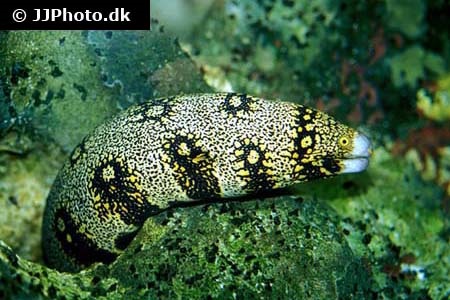Echidna nebulosa


| Latin name | Echidna nebulosa - (Ahl, 1789) |
|---|---|
| Local name | Snowflake Eel |
| Family | Muraenidae - Echidna |
| Origin | East Indian Ocean, Australia, The Red Sea, Indonesia, East Pacific, Central/West Pacific |
| Max length | 100 cm (39.4") |
| Minimum volume |
400 l (106 gal) |
|---|---|
| Hardiness |
Hardy |
| Suitable for aquarium |
Suitable with care |
| Reef safe |
Reef safe with caution |
| Aggressiveness | Might be aggressive towards similar species |
| Recommended |
Fish Larger crustaceans (Shrimp, crabs...) |
|---|
Morays can easily escape from aquaria, they can even move loose lids and glass covers without problems.
This species may eat small fish and especially small shrimps, there are, however, some aquarists who manage to get them to coexist just fine.
Morays should be fed a large meal every 3-4 days, as they otherwise can harm themselves by over eating.
If one has problems with getting the Morays to eat frozen fish or crustaceans, try moving the food in front of the fish with a tweezer.
Do note, that the food must be varied and raw/fresh, whole shrimps or smelt (small fish) for example.
It can take a week before they start feeding in the aquarium, but this is not a problem.
Try feeding them live fish or shrimp if the Morays iare not eating frozen foods after a week.
This species has a habit of rearranging rocks and sand.
Make sure rocks are placed securely on the substrate, so they cannot toppled over.
This species needs good hiding places, for example, between live rocks.
This species can change gender from female to male.
When a male is needed, a female changes sex and takes on the role.
This Moray, is one of the calmer species, and can often be kept with fish, when fed sufficiently
Be cautious when keeping larger individuals.
Moray eels (Muraenidae) are predatory fish that will most commonly live off fish or crustaceans.
To avoid overfeeding, the Moray must only be fed every 3-4 days, but may then also have a large meal.
They may dig up the substrate or move loose objects in the aquarium, so fastening the rocks and corals to the tank is a good idea.
Moray eels can easily escape from the tank if not tightly closed. They can lift lids and glass covers, do not underestimate their escape ability.
It is important that the Moray can, with its full length, hide between the rocks.
There are a few Moray eels which are suitable for reef aquaria, but the bigger species can only live in large tanks with other big fish.
Many Morays have a slightly poisonous bite, although it is not normally dangerous for people. One must not underestimate the strength of their bite however.
| Aquarium trade | Yes |
|---|---|
| Distribution | Indo-Pacific: Red Sea and East Africa (Ref. 33390) to the Society Islands, north to southern Japan and the Hawaiian Islands, south to Lord Howe Island; throughout Micronesia. Eastern Central Pacific: southern Baja California, Mexico and from Costa Rica |
| English common names |
Snowflake moray Snowflake eel Starry moray Bosch's moray Bosch' moray eel |
| Danish common names |
Stjernehimmel-muræne |
Scott W. Michael. 2001. Reef Fishes volume 1 - TFH Publications / Microcosm Ltd. - (English)
Frank Marini. 2002. A Serpent For Your Reef Tank: A Look at Fish-Safe Eels - Reefkeeping Magazine - (English)
Mike Maddox. 2009. Morays! - Tropical Fish Hobbyist Magazine - (English)
Kirby Adams. Five Favorite Eels - Wet Web Media - (English)
Bob Fenner. The Moray Eels, Family Muraenidae, pt. 1 - Wet Web Media - (English)
Bob Fenner. The Moray Eels, Family Muraenidae, pt. 2, Less Aquarium Suitable Species - Wet Web Media - (English)
Marco Lichtenberger. 2007. Moray Eels Bite—But Are They Poisonous? - Tropical Fish Hobbyist - (English)

